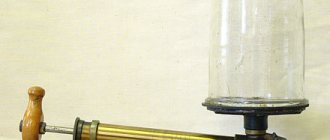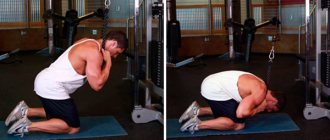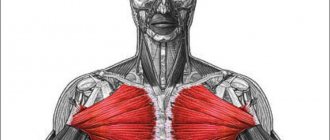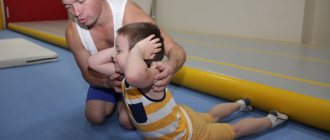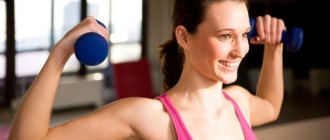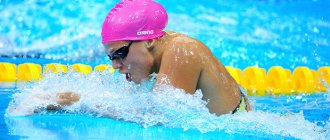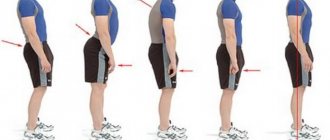- January 28, 2020
- Workouts in the gym
- Maria Klencheva
The wrestler's neck is not made separately from the body. Impressive volumes in this area should be achieved by fully pumping all large muscle groups. This is what the professionals say, and this is how our nature works. A strong neck may be thin, but a “bull” neck is always the result of correct, well-structured training aimed at hypertrophy.
Anatomy of the neck
I propose to briefly plunge into all the intricacies of one of the most important parts of our body. In anatomy, it is customary to divide the neck muscles into three parts:
- Deep, responsible for the movement of the head: its tilts to the sides, back and forth, as well as rotation. They, in turn, are divided into two subgroups: lateral - distant from the axis of the spine and medial - located closer to the axis. It is this group that includes an array of muscles called the long extensors of the neck.
- Median, actively involved in such important processes as swallowing, mouth opening and speech formation. We are less interested in them than others
- Superficial, represented by only two muscles: the subcutaneous cervical and the sternocleidomastoid. The first one tightens the skin, protecting the saphenous veins from compression. The second one turns its head and throws it back
Don’t forget about the trapezoid, which covers a whole layer of deep muscles. It is the developed upper trapezoidal beams that give the neck the shape of a cobra. This muscle is responsible for turning the head in its direction, with unilateral contraction, and for tilting the head back. When the head is fixed, the upper beams raise the shoulder blades
Why train your neck?
- Health. Perhaps you think it's better to do one extra biceps exercise than to train your neck. Meanwhile, our cervical spine needs a reliable muscular frame
- Safety. For fighters, we can use the term resilience. A strong neck will help you withstand the blows of your opponent in the ring.
- Impressive appearance. As a bonus, you get a serious argument in an argument and just a powerful part of the body that will impress others. Well, or it just won’t stand out from the overall picture of your muscular body
Strength exercises for proper neck pumping
It is necessary to perform exercises for the trapezius on the days of training the upper back, exercises for the deltoids - on the days of working the shoulders and chest.
Pure exercises for pumping up the neck muscles - these are lifts, lying on your stomach or back with weights, can be easily performed on any rest day, or when working out other parts of the body. These exercises are really very simple, and they can pump up the neck muscles very effectively. The only most important condition is to perform them correctly, follow the regime and not overload the body with various workouts. It is very important to eat right, get enough sleep, and then a positive result will not be long in coming.
Preparation and warm-up
Before any workout, you need to warm up your muscles. This is especially important for the cervical region, because any injuries can affect the quality of life.
If you already have neck problems, then you need to take this fact into account when creating a training program. Forget about dynamic exercises using additional weights. But static loads will be just right. But more on that later.
Warm-up:
- Tilts the head to the sides and back and forth. You can divide the movement into two parts, or you can combine it into one exercise. Before starting, lightly massage your neck with your hands.
- Head turns. Stand up straight, straighten your back. Direct your gaze forward and tuck your chin in slightly. Smoothly turn first to one side until you feel a slight stretch in the muscles, and then to the other.
- Tilt your chin to your chest. A good movement for stretching the deep muscles of the neck. All you need to do is smoothly reach your chin to the jugular fossa (the depression above the sternum).
Perform 5-10 repetitions of each movement, after which you can begin the main workout.
It looks manly
The neck is what is always visible.
If your head sits on a normal neck, then you will look impressive and courageous.
If your poor head barely stays on your neck, like Loch Lokhych’s, then you won’t make the best impression.
Wrestlers have thick, meaty necks, and this is what gives them a brutal, masculine look.
They do special neck exercises, which we will talk about in the next article, where I will teach you how to shake your neck.
We live in Russia - and here you wear a T-shirt for 2 months, and a fur coat for 10 months.
So no one sees your biceps for 10 months.
But the thick neck is visible all year round.
Imagine that you are in the fall, wrapped in your leather jacket, approaching a girl.
The only way she can determine that you are a tough guy is to see the only muscle that is visible - and it’s not the brain, but the neck!
How to pump up your neck at home?
You don't have to go to the gym to get a healthy neck. After all, for classes you may not need anything at all!
Let's start with gymnastics, which can be performed by both an unprepared healthy person and those who have problems with the cervical spine. But I would recommend that the last group of people first contact a specialist and get the go-ahead to train!
A set of static exercises at home:
- Place your palms on your forehead. Now try to tilt your head forward, overcoming the resistance of your hands. It is important that the neck and head do not move, since we are working statically. Start with 3-4 sets lasting 5-10 seconds. Over time, increase the time of muscle tension to 15-20 seconds and increase the resistance force
- Grasp the back of your head with your hands and perform a similar movement. But now you need to try to tilt your head back. Try to do the same number of approaches as in the first exercise.
- Press your palm onto the side of your head, above your ear. Try to tilt your head to the side, overcoming the stubborn palm. After completing 3-4 sets on one side, repeat the same on the other side.
When making this or that movement, you do not need to move your neck towards the resisting hand, but rather turn it. That is, try to perform a rotational movement with your head! This complex will not significantly affect muscle volume, but will help to effectively strengthen the corresponding part of the spine!
Dynamic exercises:
This is the next level. For those who do not have diseases or injuries of the cervical spine.
- Take the previous exercises and perform them not in a static mode, but with head movement
- Another option is to use a towel. Fold it in half and hold its two ends tightly in your hands. You will get a loop that needs to be placed around your head (not around your neck). And do all the same exercises
Easily? Find a partner. Let him now take a towel and use it to apply pressure to your head. These exercises are quite enough if your goal is to strengthen your muscles and give them an expressive look.
Why doesn't my neck grow?
One of the most important reasons is the lack of heavy basic exercises and strength progression in the training program.
Not all athletes and athletes can boast of a wrestler's neck. The increase in muscle volume in this area occurs mainly through performing basic exercises. But the direct “involvement” of muscle work through isolation exercises is clearly overrated in terms of growth.
This means that it will be unrealistic to pump up the “bull neck” by training specifically with your own weight, light weights or little resistance.
It has been noted that heavy strength exercises provide an increase in body weight, including an increase in volume in the cervical spine. Depending on the execution options, the target muscles can participate indirectly, but even then the resulting load will provoke hypertrophy.
Correcting goose neck can be difficult not only for those who neglect basic exercises and train haphazardly. This process can be affected by diet, environment, genetics, and even stress!
Weight training
Currently, there is a lot of different equipment that can be used for training.
- Training with TPX loops. There is such a popular exercise among fighters as the wrestling bridge. Using TPX loops you can do a lighter version of this exercise! Take the loops in your hands and interlock your fingers. Place your forehead on the back of your hands. Take a position so that your body is slightly tilted forward and has only two points of support: your feet resting on the floor and your forehead resting on the back of your hands. In the starting position, the whole body is extended into a “string”. The cervical spine has a natural deflection. Gently tilt your head forward, then return to the starting position. Perform 2-3 sets of 10-15 repetitions. As your training progresses, increase your forward bend. Similarly, you can bend to the sides and tilt your head back.
- With disk. All you need is a pancake with a value of 5 to 20 kg and a towel. Lie down on a bench press bench with your head and neck extending beyond the bench. If you are going to do an exercise on the muscles that extend or flex the head and neck, then place the disc on the back of the head or forehead, respectively. For lateral bending, place a plate on the area above your ear.
- With a head helmet. Of course, you can avoid the inconvenience of the “pancake + towel” design. But for this you will have to purchase a harness.
The exercise is most conveniently performed while sitting on a bench. To load the extensor muscles, lean your entire body forward and place your hands on your hips. By taking the “lying on your side” position, you will pump up the muscles responsible for tilting your head to the side. And if you lie on your back, you can give a load to the sternocleidomastoid (thrusting the head forward) muscles. Since the harness is a special device for training the neck muscles, it allows you to specifically load the muscles.
By using relatively heavy weights, you can achieve significant results in increasing muscle strength and volume. But keep in mind that the neck is a rather vulnerable organ and should be trained with extreme caution.
Use weights in your exercises that will allow you to perform 10-12 repetitions with the most correct technique!
You can learn more about the basic rules and exercises for training your neck at home in the following video
Training without weights
The US Trainers Association has a universal training methodology. It includes three basic exercises. We already know one of them, lateral neck bends with a harness. I will present the remaining two below:
- Straight wrestling bridge. You probably did everything in school on the bridge in physics. So, the wrestling version is performed without hands. The head acts as a fulcrum. Use your hands to help yourself to the starting position. The head should be slightly tilted back. Once in the desired position, remove your hands. Then begin to smoothly roll towards your legs, thereby increasing the load on the neck extensor muscles
- Reverse wrestling bridge. This exercise must be supplemented with a regular wrestling bridge to maintain balance in the development of neck muscles. After all, in this execution the exercise trains the anterior cervical muscles. Due to the complexity and risk of injury, I recommend performing them only under the supervision of an experienced trainer.
Shaking our necks in the hall
In the gym, in addition to such devices as TPX loops and harnesses, you can use a special exercise machine.
Let's figure out how to use this simulator to pump the front and back of the neck.
- Exercises for the posterior muscles. Sit in the machine with your back to the roller. Adjust its height so that it rests on the back of your head. Slowly move your head back, overcoming the resistance of the roller. Then also slowly return to the starting position. Perform 2-3 sets of 10-12 repetitions. As additional exercises, you can use extensions with a disc or harness.
- Exercises for the sternocleidomastoid muscles. Now turn your face to the roller and rest your forehead against it. Bend your head forward, overcoming the weight, then return to the starting position. Again, 2-3 sets of 10-12 repetitions will be enough. To diversify your workout, do 1-2 approaches in TPX loops.
- Trapezium exercises. Everything here is classic. Only shrugs, only hardcore.
With what weight to perform the movement is up to you. This could be dumbbells, barbells, weights or a special machine. The main thing is to do 2-3 sets of 10-15 repetitions
- Deltoid exercises. The painting will not be complete if the shoulders lag behind. Therefore, pay enough attention to them! The best movement for the shoulders is abduction.
In second place are pull-ups or barbell rows to the chin.
And only on the third bench press.
Why is that? Because the shape of the shoulders is formed by the developed middle deltas, and they receive maximum load in the first two exercises! For all movements, perform 2-3 sets of 10-15 repetitions.
Neck training improves your posture
It's the twenty-first century, and we spend a lot of time sitting in front of computers and phones.
It harms your neck and posture.
Perhaps you've been sitting so long at the computer that you have the posture of a giraffe (left):
If so, it's time to fix it urgently!
I'm just shocked how many normal-looking guys walk down the street like in the picture on the left - and because of this they look like complete idiots.
By training your neck, you correct your posture and look like a man.
You start pumping today - and very soon your neck will no longer be like Lokh Lokhych’s, and will become like Bull Bykovich’s!
Now that I've convinced you, let's get started on how to pump up your buffalo neck, wrestler's neck, local kingpin's neck, Mike Tyson's neck, Corey Taylor's neck!
Click here and read how to pump up your neck.
See you later.
Vlad Makeev.
- Repost
- Repost
- Retweet
Genetic features and conclusion
For any muscle group, genetics plays a big role in shaping the appearance of muscles. For example, the height of the trapezius can vary significantly from person to person, and the point is not in training, but in the length of the tendons with which it is attached to the back of the head. In addition, the length of the neck may differ. People with long necks will have a harder time building muscle.
But all these differences do not mean that you will not be able to make this part of the body strong and strong! The main thing is to determine which exercises are right for you and show a little perseverance! That's all. I hope the article was useful. Subscribe to updates and don't forget to share information with your friends. See you soon!
The importance of neck muscle training
A strong male neck is the beauty and health of its owner. The aesthetic function of pumped-up neck muscles is indisputable, because with a developed chest, broad shoulders and sculpted arms, they should look trained. If athletes striving for high results have a question about why they should pump their necks, they just need to look at the photos of titled bodybuilders. They will be an excellent confirmation of the need to include exercises for the neck muscles in the training process.
Women should also pay attention to this muscle group, because the open décolleté area is their prerogative. Of course, women's training should not include exercises with heavy weights, because in this case, the elegance of the outline is important, not the size of the muscles. If athletes are wondering whether girls need to shake their necks, it is worth remembering that this is the area that begins to age first of all. Trained neck muscles will help you avoid sagging skin and a double chin, and therefore generally improve your appearance. By paying attention to this area, girls not only improve their décolleté area, but also prolong its youth.
A strong neck is also very important for the health of an athlete. Developed muscles prevent the development of osteochondrosis and neck pain. Since many blood vessels and nerve endings pass through here, a healthy neck is the key to normal intracranial pressure, the absence of spasms and migraines. This is also additional support for the spine, which will not be superfluous for anyone.

